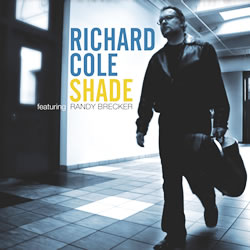 This Friday, January 4th, saxophonist Richard Cole celebrates the release of his new CD, Shade, at Tula’s Jazz Club. Joining Rich will be Bill Anschell (piano), Chuck Deardorf (bass), Gary Hobbs (drums) and Thomas Marriott (trumpet). John Hansen, Dr. Ronald Cole and John Bishop will be sitting in as well. It should be good!
This Friday, January 4th, saxophonist Richard Cole celebrates the release of his new CD, Shade, at Tula’s Jazz Club. Joining Rich will be Bill Anschell (piano), Chuck Deardorf (bass), Gary Hobbs (drums) and Thomas Marriott (trumpet). John Hansen, Dr. Ronald Cole and John Bishop will be sitting in as well. It should be good!
This new release showcases the versatile saxophonist in like-minded and stellar company. With trumpeter Randy Brecker again making an appearance, Shade is instantly compelling. Both rollicking and serene, Shade varies the program, from the fusion-informed “Red Hat” to the modern impressions of “Beautiful Love” and “I Could Write a Book” while showcasing several dynamic originals including the opening track “A Shade for Joe,” a nod to the great Joe Henderson. Shade also features pianists Randy Porter, Marc Seales and John Hansen, bassists Chuck Deardorf, Jeff Johnson, and Chuck Bergeron, drummers Gary Hobbs and John Bishop, among others.
(Click here to listen to sound clips from Shade and also purchase the CD from Origin Records)
SJS: What is the story on putting this recording together?
Richard Cole: Actually the songs were recorded over a period of about seven years! We had one left over from the The Forgotten recording sessions from 2000. That song was “A Shade of Joe.” The next session was in May of 2005. We did a few then with the intention of finishing up soon. Unfortunately I had to table the project because of the death of my parents, and then the opening of an art gallery (Cole Gallery in Edmonds, WA) with my wife, Denise. I was able to get back to it May of 2007. Whew!
How did you decide on this collection of musicians?
The songs themselves recommend certain musical personalities. It’s kind of a deliberate but organic decision making process for me.
How did you come to work with Randy Brecker?
Randy was recruited for The Forgotten by the producer and bassist, Chuck Bergeron. Chuck was trying to generate enough work for Randy to come out to Seattle. I was in the middle of my project at that time and Chuck recommended hiring him. After Randy heard me play, he asked if I would play on his gig here in Seattle so he could use his quintet arrangements. I just about had a heart attack! Anyway I called him to play on Shade. He’s going to be on the next one too—that one is about half done.
How did the choice of repertoire come about? Which tunes did you write? How do you decide which standards you want to record and then determine how to approach them?
This was really mostly a bunch of tunes Bill Anschell and I had been playing over the last few years. My lone original on this one is “A Shade of Joe.” I arranged “You Don’t Know What Love Is” and co-arranged “I Could Write A Book” with Bill. With the exception of Beautiful Love which as a group arrangement, the songs were written or arranged by myself, Bill or my brother, Ron. Ron and Bill’s personalities are very strong on this recording.
I usually choose standards by their strong melodic qualities and the potential of “messing” with them. They usually have to have an open quality for that reason. This recording was no exception. Often times I’ll be playing a standard on a gig and something will pop into my head. I’ll do an arrangement later based on that idea. Other times things just evolve on the bandstand. That’s what happened with “Beautiful Love.” I “Could Write a Book” started out that way too, then Bill and I formalized it. (Denise and I picked that as “our song” a couple years ago so I had been playing it a lot.)
What’s the meaning of the title Shade?
Shade is a word pulled from the title of the lead tune, “A Shade of Joe.” In the art gallery that Denise and I own and Denise runs, I have been surrounded by the works of many great artists. Each painting consists of values and colors, of light and dark, sunlight and shade as part of its overall artistic makeup. But beyond that, each work has its own shade of personality. This is what I meant in the CD title. Each musical piece is a vignette, scene or story. Some have dedications. Some are more “mood scenes.”
Who are your three biggest artistic influences, saxophone or otherwise?
I started out as a classical clarinetist but when I heard Coltrane, it was all over for that. For sax: Trane, Joe Henderson, Sonny Rollins, Wayne Shorter, Dave Liebman, Bob Berg, Mike Brecker, Billy Harper, Ernie Watts and more recently Walt Weiskopf and Kenny Garrett. I’m skipping dozens here!
Overall musically: Miles, Trane, Herbie Hancock, Weather Report, Randy Brecker, Horace Silver and a million others. The first heavyweight jazz band I saw was Horace Silver with Tom Harrell, Bob Berg, Mike Richmond and Alvin Queen. That band made me want to play jazz.
Where are you going in such a hurry in the cover photo?
Cleveland.